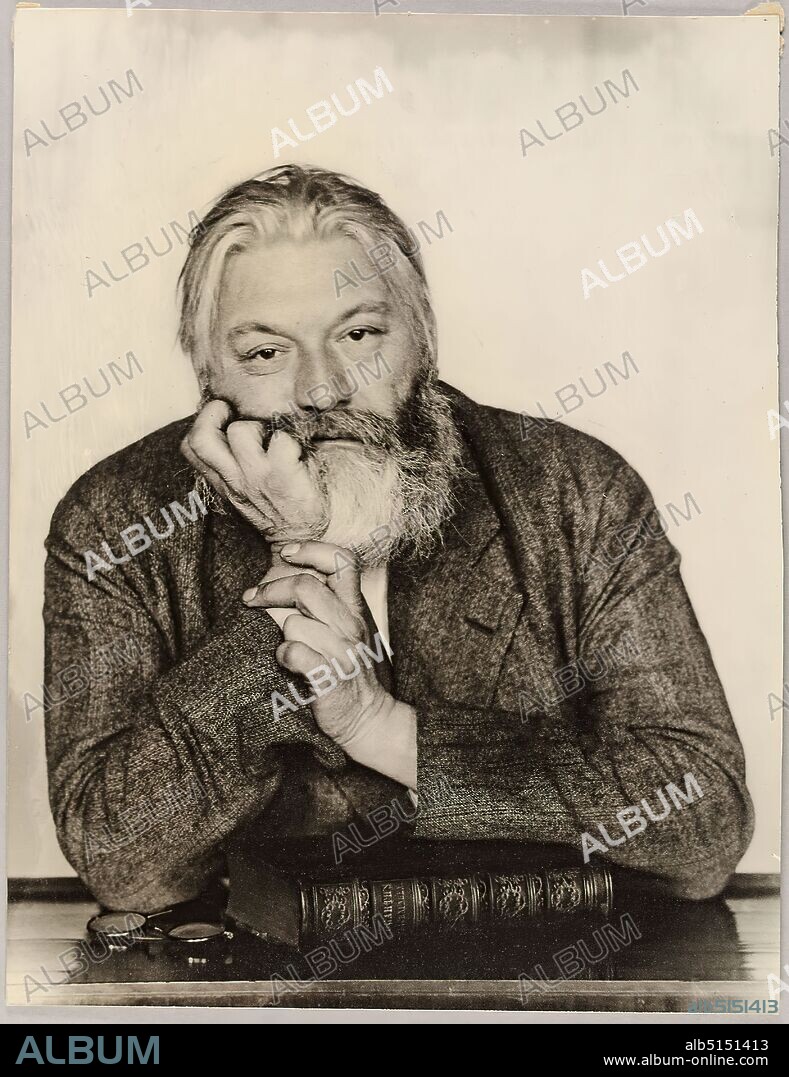alb5151413
Hugo Erfurth, Theodor Däubler, Staatliche Landesbildstelle Hamburg, collection on the history of photography, silver gelatin paper, black and white positive process, retouched (stone processing), image size: height: 25.4 cm; width: 19.8 cm, upper left in lead: Däubler, upper right: 88; lower left: beginning of d. 20's, (according to P. Oehmen), portrait photography, writer, poet, author, portrait, half-length portrait, arm positions, gestures, book, eyeglasses, glasses, Theodor Däubler, At the beginning of the 20th century, Hugo Erfurth is one of the most famous professional photographers in Germany, along with Rudolph Dührkoop and Nicola Perscheid. After completing an apprenticeship as a photographer, he opened his own studio in Dresden at the age of only 22. Soon Erfurth orientated himself towards the up-and-coming pictorialist photography, participated in numerous amateur photographic exhibitions from 1894 onwards and managed to make a name for himself both as an artistically ennobled amateur and successful professional photographer. Portraits are central to his work, which he began taking in 1906 in his new studio, a classicist palace, in a stylishly elegant ambience, appealing to the wealthy bourgeoisie. He also produced numerous portraits of famous personalities, including Käthe Kollwitz, Otto Dix and Joachim Ringelnatz. While his studies around 1905 still show full-length figures depicted in an atmospheric way, from the 1920s onward the focus is on the face, which is photographed against a simple monochrome background. Here, his pictorial approach corresponds to the portrait of classical modernism, whereby the technique of oil printing emphasizes the softness and materiality of the pigments and at the same time places the portraits in the art-photographic tradition. Erfurth is a co-founder of the Gesellschaft Deutscher Lichtbildner (1919), teaches at the Leipzig Academy and moves from Dresden to Cologne in the 1930s, where he builds up an art collection.

|
Ajouter à une autre Lightbox |
|
Ajouter à une autre Lightbox |



Avez-vous déjà un compte? S'identifier
Vous n'avez pas de compte ? S'inscrire
Acheter cette image.
Sélectionnez l'usage:

Légende:
Voir la traduction automatique
Hugo Erfurth, Theodor Däubler, Staatliche Landesbildstelle Hamburg, collection on the history of photography, silver gelatin paper, black and white positive process, retouched (stone processing), image size: height: 25.4 cm; width: 19.8 cm, upper left in lead: Däubler, upper right: 88; lower left: beginning of d. 20's, (according to P. Oehmen), portrait photography, writer, poet, author, portrait, half-length portrait, arm positions, gestures, book, eyeglasses, glasses, Theodor Däubler, At the beginning of the 20th century, Hugo Erfurth is one of the most famous professional photographers in Germany, along with Rudolph Dührkoop and Nicola Perscheid. After completing an apprenticeship as a photographer, he opened his own studio in Dresden at the age of only 22. Soon Erfurth orientated himself towards the up-and-coming pictorialist photography, participated in numerous amateur photographic exhibitions from 1894 onwards and managed to make a name for himself both as an artistically ennobled amateur and successful professional photographer. Portraits are central to his work, which he began taking in 1906 in his new studio, a classicist palace, in a stylishly elegant ambience, appealing to the wealthy bourgeoisie. He also produced numerous portraits of famous personalities, including Käthe Kollwitz, Otto Dix and Joachim Ringelnatz. While his studies around 1905 still show full-length figures depicted in an atmospheric way, from the 1920s onward the focus is on the face, which is photographed against a simple monochrome background. Here, his pictorial approach corresponds to the portrait of classical modernism, whereby the technique of oil printing emphasizes the softness and materiality of the pigments and at the same time places the portraits in the art-photographic tradition. Erfurth is a co-founder of the Gesellschaft Deutscher Lichtbildner (1919), teaches at the Leipzig Academy and moves from Dresden to Cologne in the 1930s, where he builds up an art collection.
Personnalités:
Crédit:
Album / quintlox
Autorisations:
Modèle: Non - Propriété: Non
Questions sur les droits?
Questions sur les droits?
Taille de l'image:
3330 x 4320 px | 41.2 MB
Taille d'impression:
28.2 x 36.6 cm | 11.1 x 14.4 in (300 dpi)
Mots clés:
ALLEMAGNE • APPELER • ARCHIVE • ART, PHOTOGRAPHIE • AUTEUR • AUTEURS • CORPS VISAGE • ECRITURE LIVRES • ÉCRIVAIN • ETUDES • FACE • GESTE • GESTUALITE • HISOIRE • HISTOIRE • HUGO ERFURTH • INSTANTANE (PHOTO) • INSTANTANÉ • JOACHIM RINGELNATZ • LAISSÉ • LIVRE (OUVRAGE) • LIVRE • LIVRES • LUNETTE • LUNETTES • NICOLA PERSCHEID • NOIR • PHOTOGRAPHIE • PINCE-NEZ • PORTAIT • PORTRAIT • POTRAIT • SNAPSHOT • TECHNIQUE • TECHNOLOGIE • TRAVAIL DE LA PIERRE • VISAGE • VISAGES • XXE SIECLE
 Pinterest
Pinterest Twitter
Twitter Facebook
Facebook Copier le lien
Copier le lien Email
Email
